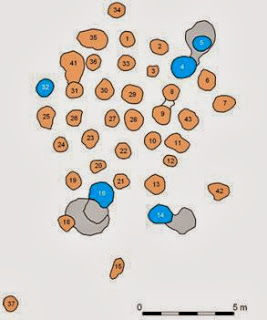Central area of the complex of encosures of Monte da Conteda (magnetogram from Helmut Becker). A very complex site, with more than 20 ditched enclosures with very different layouts and chronologies.
In the 1st of January of 2013 I wondered if this year
would be a good year for Portuguese Prehistoric enclosures research. And it
certainly was so. Apart from the development of research project and rescue
excavations on sites already known, this year saw the discovery of several new
enclosures in Alentejo hinterland. Monte das
Cabeceiras 2, Herdade da Corte, Monte da Contenda, Figueira, Borralhos, Folha
do Ouro 1, Nobre 2, Lobeira de Cima, Coelheira 3, Montoito are ten new enclosures detected in 2013.
Eight of them were discovered in the context of a
research program and two were already submitted to geophysical prospection with
very good results.
In a time of decay of the investment in archaeological
research in Portugal, these results, for Alentejo’s Recent Prehistory, are not
bad at all.












































